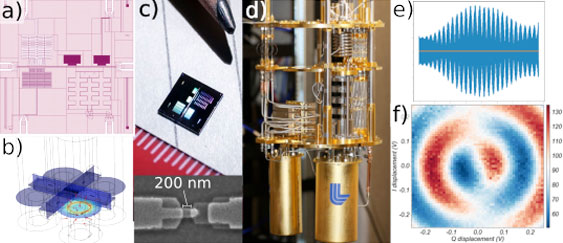Jonathan DuBois
Overview
We have developed a robust capability to design, fabricate, characterize, and optimize the performance of quantum coherent materials and devices for applications in sensing, analog quantum simulation, and quantum computing. The team has also made significant contributions to the understanding and amelioration of noise sources in superconducting quantum circuits, developed and implemented the skill sets required to design and fabricate novel quantum sensors and quantum computing devices, and formed strong partnerships with leading groups in academia, industry and other national labs to further the development and application of quantum devices and materials. The key technical accomplishments resulting from this project include the following:
- establishment of world-class quantum materials and quantum computing testbed laboratories
- development and testing of novel quantum computing architectures optimized for near-term applications in scientific quantum computation and simulation
- demonstration of novel applications of advanced manufacturing methods for quantum sensing and materials
- development of new quantum sensing platforms designed to probe the materials sources of quantum decoherence in quantum devices
- demonstration of a multiplexed readout of cryogenic detectors for high-resolution spectroscopy
- discovery of new quantum materials properties in topological insulators (TI) and emergent superconductivity in composite TI and normal metal structures
- realization and application of a novel control-centric approach to efficient realization of quantum algorithms on current and near-term quantum computing hardware
Background and Research Objectives
Quantum coherent devices offer the potential for both unprecedented precision as sensors and, when carefully designed and controlled, offer the potential to directly simulate quantum phenomena for which there are no known efficient classical algorithms. The performance of these systems is largely limited by resonant couplings to low energy states in the constituent materials (i.e., materials-based sources of noise). Overcoming this limitation requires that subtle forms of noise and decoherence in these systems be understood and controlled.
Building on Lawrence Livermore National Laboratory’s experimental and theoretical expertise in materials and condensed matter physics, as well as cryogenic detectors, we aimed initially to disentangle and overcome the different contributions of noise and decoherence that reduce performance in quantum devices. Expected results included new capabilities in design, fabrication, and characterization of quantum coherent devices and new insights into materials-based sources of noise in these systems. Initial target applications included development of a qubit-based, gigahertz-frequency, single-photon detector to enable the search for axion dark matter and multiplexed cryogenic detector arrays for applications in high-fidelity x-ray and gamma spectroscopy.
Over the course of this strategic initiative, these goals were met by demonstrating single-photon-number state creation, readout, and control in a superconducting resonant cavity coupled to a qubit (a unit of information in quantum computing) and, in parallel, fabrication and testing of a frequency-multiplexed, magnetic microcalorimeter array. Other accomplishments included the following:
- establishing a low-noise test facility and demonstrating characterization of qubits
- developing a fabrication process for superconducting quantum coherent devices
- developing multiple experimental platforms for characterization, control, and amelioration of materials-based sources of decoherence and noise
- developing a theoretical framework to guide the design of a quantum emulation test bed capable of universal emulation of complex many-body quantum dynamics
- discovery of a new class of high-kinetic-inductance superconducting materials with broad potential applications in quantum sensing.
Finally, the most significant achievement under this effort was the development of a quantum computing and simulation testbed laboratory and a radical new quantum device architecture based on manipulation of cavity photon states in the coupled anharmonic modes of a specially designed superconducting resonance cavity. This architecture, called the busmon, naturally allows for a higher level of connectivity and long-lived quantum states than existing planar arrays of superconducting qubits, resulting in faster, more complex entangling operations and realization of more complex quantum algorithms.
The following figure illustrates some of our accomplishments.
Impact on Mission
This research supports multiple LLNL core competencies, including high-performance computing and advanced materials and manufacturing through the development of materials and systems for quantum enhanced sensing, prototypes of quantum computing and quantum simulation testbeds, and new approaches to applying quantum coherent systems to NNSA mission-relevant computational challenges. Future development has the potential to dramatically impact the central scientific computation component of Laboratory’s stockpile stewardship program through improved computational fidelity and efficiency, enabled by quantum computing and simulation.
Conclusion
During this project we developed a robust capability to design, fabricate, characterize, and optimize the performance of quantum coherent materials and devices for applications in sensing, analog quantum simulation, and quantum computing. Our key accomplishment was the development of a quantum computing and simulation testbed laboratory and a radical new quantum device architecture based on the manipulation of cavity photon states in the coupled anharmonic modes of a specially designed superconducting resonance cavity. Following the advances made under this strategic initiative, the LLNL quantum coherent device team will continue development of increasingly powerful quantum computing and simulation architectures and applications at the cutting edge of scientific quantum computation. Continued research focused on co-design of quantum hardware and hardware-aware quantum algorithms is now sponsored by the DOE Office of Science Advanced Scientific Computing Research (ASCR) under the "quantum testbed pathfinder" program, as well as the NNSA’s Advanced Simulation and Computing (ASC) program under the "Beyond Moore’s Law" program.
Publications and Presentations
Dubois, J., et al. 2017. "Report to Lincoln Labs on TWPAs," LLNL-TR-739446. doi: 10.2172/1399728. LLNL-TR-739446.
Holland, E. T., et al. 2017. "High-Kinetic Inductance Additive Manufactured Superconducting Microwave Cavity," Applied Physics Letters, 111(20), p. 202602. doi: 10.1063/1.5000241. LLNL-JRNL-733239.
Holland, E., et al. 2017. "Additive Manufactured Superconducting Cavities," in APS Meeting Abstracts, p. Y46.012. LLNL-ABS-708947.
Ray, K., et al. 2018. "Emergent Dynamics of Noise and Loss-Generating Paramagnetic Spins in Superconducting Circuits," Bulletin of the American Physical Society. APS March Meeting, Los Angeles, CA, March 2018, p.Y33.006. LLNL-ABS-741224.
Rosen, Y., et al. 2018. "Probing Micro-eV States at the Material Interfaces of Superconducting Devices," Bulletin of the American Physical Society. APS March Meeting, Los Angeles, CA, March 2018, p.X39.008. LLNL-PRES-747430.






